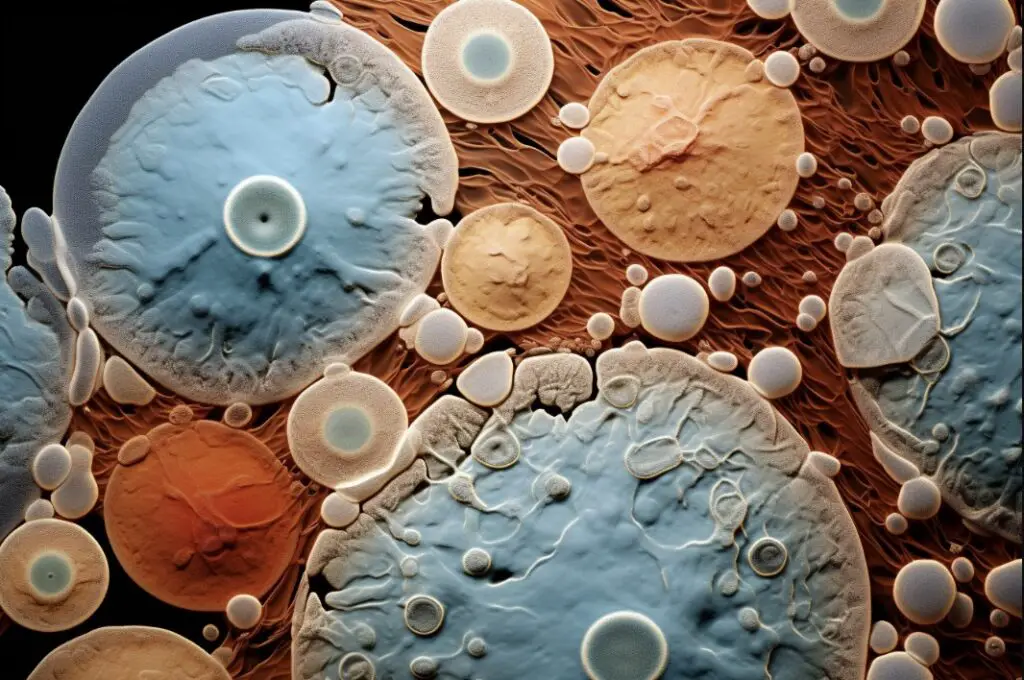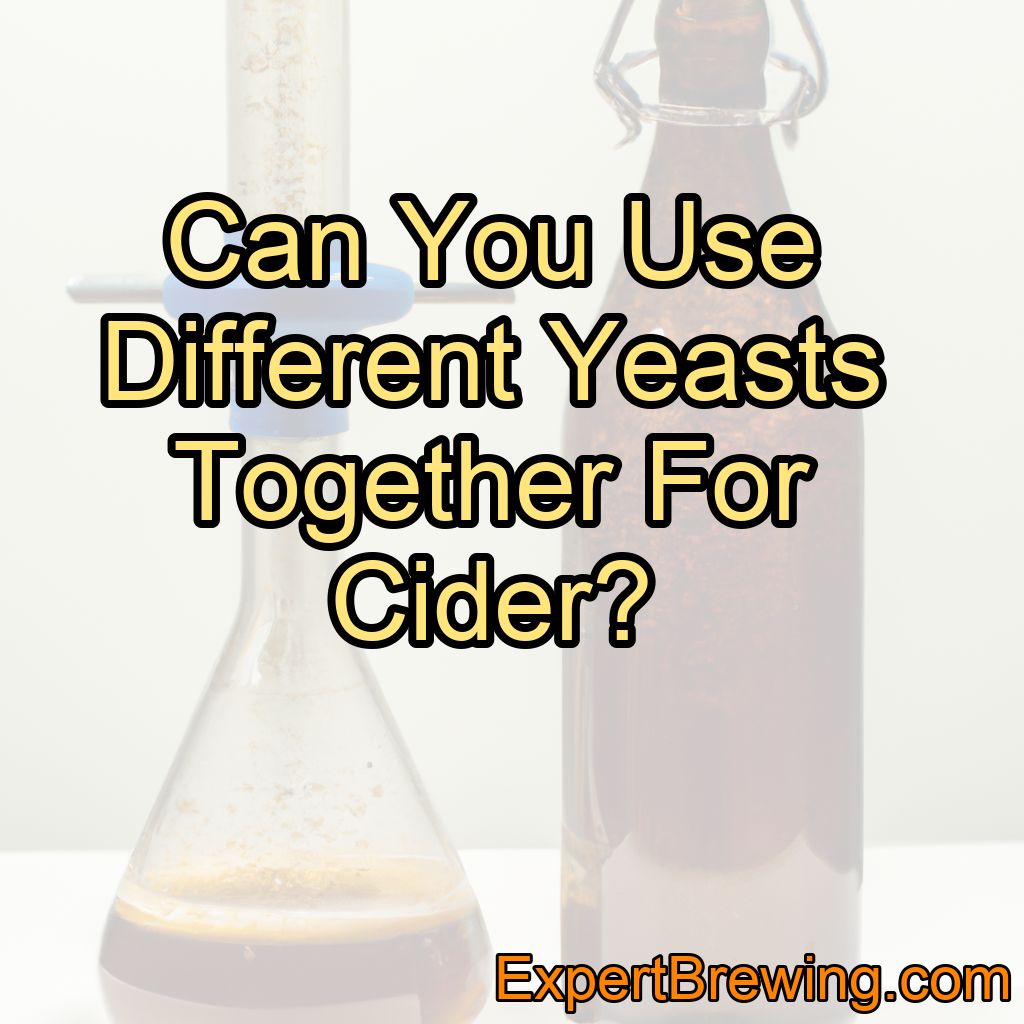Cider brewing is a fascinating process, an art form that combines science, patience, and creativity. One pivotal element in the brewing process is the yeast.
Yeast is responsible for the fermentation process, which converts the sugar in the apple juice into alcohol. It can significantly impact the flavor, aroma, and overall quality of the cider.
So, can you use different yeasts together for cider?
In short, yes, you can use different yeasts together when brewing cider. It’s a technique often called “yeast blending”.
It’s a bit of an experiment as the end result can vary greatly depending on the types and amounts of yeasts used.
This post will delve deeper into the complex world of yeast blending, showing how it can enhance or alter your cider’s characteristics.
Yeast Blending: A Bold Experiment
Brewing, at its core, is a grand experiment. Yeast blending is no different. When you blend yeasts, you’re essentially creating a new recipe. Different yeasts have different characteristics and influence the cider’s flavor, aroma, and even color in unique ways.

For example, one yeast might bring out fruity notes, while another could enhance the cider’s earthy undertones.
By combining different yeasts, you can achieve a more complex flavor profile.
However, it’s important to experiment and keep track of your results, as the outcome can be unpredictable.
Blending makes most sense for cider brewing where you have no wild yeast present as a traditional wild yeast brewing is actually already a blend!
Traditional (wild) cider fermentation is already a blend!
In the realm of cider brewing, the fascinating dance of apple juice and yeast microflora creates a symphony of flavors and aromas. When I delve into the world of using multiple yeast strains, I find myself intrigued by the intricate interplay between these microorganisms.
You see, when we let apple juice ferment with its native microflora in what’s often referred to as a wild fermentation, we embark on a journey through three distinctive phases, each imbued with its own unique character. The duration of these phases is intimately linked to the temperature at which this alchemical process unfolds.

In the initial phase, aptly named Yeast Growth, the stage is set by the Hanseniaspora and Kloeckera genera of yeast. While Saccharomyces cerevisiae might make a timid appearance during this phase, it truly takes the reins only in the subsequent stage.
Ah, that second phase, the Alcoholic Creation! Here, the transformation of sugar into ethanol becomes the main act, choreographed by the graceful movements of Saccharomyces cerevisiae, while the presence of Hanseniaspora and Kloeckera dwindles into obscurity.
But the finale is a grand one, a phase called Maturation, where the spotlight shifts to Brettanomyces and Dekkera yeast. This enchanting phase can extend far beyond the mere 27 days depicted in the graph. It’s during this period that the stage is set for myriad transformations.
The emergence of Lactic Acid Bacteria (LAB) can usher in the era of malolactic fermentation, while a tapestry of enzymatic and chemical reactions unfold, weaving intricate layers of complexity into the cider’s fabric.
Yet, as with any artistic endeavor, the choices of technique and ingredients wield the power to reshape the narrative. Enter sulfites, pasteurization, or filtration — each a brushstroke that alters the canvas of flavors and aromas.
These interventions influence the very essence of the cider, redirecting its evolution. A judicious application of sulfites before yeast growth or post-alcohol fermentation, alongside pasteurization or filtration at any juncture, can irrevocably transform the delicate dance of fermentation.
And then, we have the intriguing option of introducing commercial yeast strains, those cultured performers poised to take center stage. By selecting a strain like Saccharomyces cerevisiae and orchestrating the temperature to align with our intentions, we can nudge the narrative, hastening or leisurely elongating the phases.
The entrance of Saccharomyces cerevisiae as a leading character might curtail the Yeast Growth phase, for it is now artificially instated. Yet, even amidst this controlled choreography, the Maturation phase, with its potential for rich transformation, remains a poignant climax waiting to unfold.
In this intricate dance between science and art, tradition and innovation, the use of multiple yeast strains amplifies the possibilities, offering the cider enthusiast a palette of flavors to explore.
As I stand at the threshold of this realm, I’m reminded that with each yeast strain we introduce, each variable we manipulate, we’re not merely brewing cider; we’re composing a symphony of taste, a tapestry of aromas that will linger on palates and memories alike.
Types of Yeasts Suitable for Blending
There are many types of yeasts that brewers use, but not all of them are suitable for blending. Some of the most common yeasts used in cider brewing include:
– Ale Yeast: This yeast is known for creating a fruity and estery aroma in ciders. It ferments at a higher temperature and leaves a slightly sweet finish.
– Champagne Yeast: Often used for its high alcohol tolerance and ability to ferment thoroughly, resulting in a drier cider. It also contributes to a very clean and crisp flavor.
– Wine Yeast: This yeast creates a more wine-like flavor profile and tends to produce a higher alcohol content.
– Cider Yeast: Specifically designed for cider brewing, these yeasts can bring out the natural apple flavors and create a well-balanced cider.
The Art of Yeast Blending
Blending yeasts is not just about throwing different yeasts together and hoping for the best. It’s an art form that requires a keen understanding of each yeast’s characteristics.
When blending yeasts, it’s essential to consider the proportions. Too much of one yeast can overwhelm the other’s characteristics, resulting in a one-dimensional flavor. A balanced blend can create a complex, multi-layered cider that is truly unique.
Yeast Blending Techniques
There are several techniques for blending yeasts. One method is to pitch the yeasts simultaneously, allowing them to ferment together. Another technique is sequential pitching, where one yeast is pitched first, followed by the second yeast after the first one has completed its fermentation. Each method has its advantages and can yield different results, so it’s worth experimenting with both.
Potential Risks of Yeast Blending
While yeast blending can create unique and exciting flavor profiles, it’s not without its risks. Yeasts are living organisms, and they can interact in unexpected ways.
One risk is the creation of off-flavors. If the yeasts compete for resources, they may produce unwanted byproducts that affect the cider’s flavor. Another risk is stuck fermentation, where the yeast stops fermenting before all the sugar is converted into alcohol, resulting in a sweet, low-alcohol cider.
How to Experiment with Yeast Blending
To start experimenting with yeast blending, begin with a small batch. This way, if the blend doesn’t work out, you’re not wasting a large amount of cider.
Keep detailed notes on the yeasts used, their proportions, the fermentation temperature, and any other variables. This will help you refine your blends over time and understand what works and what doesn’t.
Conclusion: The Beauty of Yeast Blending
Yeast blending is an exciting and rewarding process. It allows brewers to push the boundaries of traditional cider brewing, resulting in unique and complex ciders. However, it’s important to remember that blending yeasts is a bit of a gamble, as the end result can be unpredictable.
Regardless, the beauty of yeast blending lies in the experimentation and the opportunity to create something truly unique.
10 Facts About Yeast Blending in Cider Brewing:
1. Yeast blending is the process of using different yeasts together when brewing cider.
2. Different yeasts can influence the cider’s flavor, aroma, and color.
3. Ale, champagne, wine, and cider yeasts are commonly used in cider brewing.
4. Yeast blending requires a keen understanding of each yeast’s characteristics.
5. The balance of the yeasts is crucial in creating a complex flavor profile.
6. Yeast blending techniques include simultaneous and sequential pitching.
7. Yeast blending can result in off-flavors or stuck fermentation.
8. It’s best to start with small batches when experimenting with yeast blending.
9. Detailed notes can help refine blends and understand what works and what doesn’t.
10. Yeast blending is a rewarding process that allows brewers to create unique ciders.
FAQs
What is the best yeast to ferment cider?
The best yeast for fermenting cider is typically a strain of Saccharomyces cerevisiae, commonly known as wine yeast. These yeast strains are specifically selected for their ability to ferment fruit sugars and produce desirable flavors and aromas in cider. Some popular wine yeast strains for cider making include EC-1118, D47, and Cote des Blancs. Ultimately, the choice of yeast depends on the desired flavor profile and characteristics you want to achieve in your cider.
What is the highest ABV for cider?
The highest ABV (alcohol by volume) for cider typically falls between 8% and 12%. However, some specialty ciders or fortified ciders may have higher ABV levels, reaching up to 15% or more.
Can you mix different wine yeast?
Yes, it is possible to mix different wine yeast strains. Winemakers often blend different yeast strains to achieve specific characteristics in the final wine. This can enhance aroma, flavor, fermentation efficiency, or other desired qualities. However, it is important to consider the compatibility of the yeast strains and their ability to work together harmoniously. It is advisable to consult with a knowledgeable winemaking expert or supplier to ensure the successful blending of different yeast strains.
Does brewery yeast make more than 15% ABV?
Yes, brewery yeast can produce beers with alcohol by volume (ABV) higher than 15%. Certain strains of yeast, such as champagne yeast or specific high-gravity yeast strains, are often used to achieve higher alcohol content in beers. However, it is important to note that producing beers with extremely high ABV levels, such as those exceeding 15%, requires careful monitoring of fermentation conditions and may require additional steps to ensure yeast tolerance and proper fermentation.
What is the maximum ABV for beer yeast?
The maximum Alcohol By Volume (ABV) that beer yeast can typically tolerate is around 12-15%. However, some specialized yeast strains can handle higher levels, reaching up to 18-20% ABV in certain conditions.
What is the maximum ABV for cider yeast?
The maximum ABV (alcohol by volume) for cider yeast typically ranges between 12% and 15%. However, some specialized strains of cider yeast can tolerate higher alcohol levels, reaching up to 18% ABV. It’s important to choose a yeast strain that matches your desired alcohol content when fermenting cider.
References
www.pricklycider.com/2020/12/09/the-3-phases-of-natural-fermentation/
W.F. Morrissey and associates, The role of indigenous yeasts in traditional Irish cider fermentations, 2004 The Society for Applied Microbiology, Journal of Applied Microbiology, 97, 647–655.




